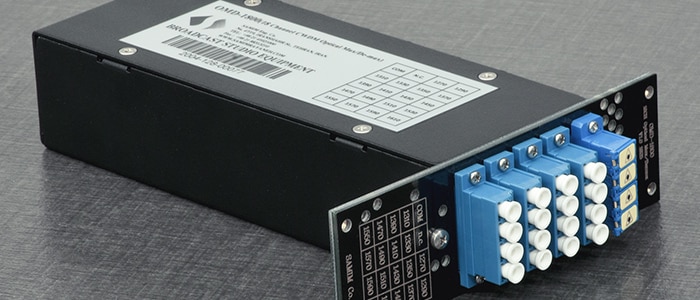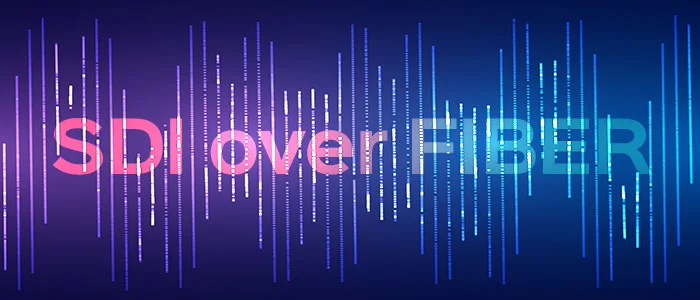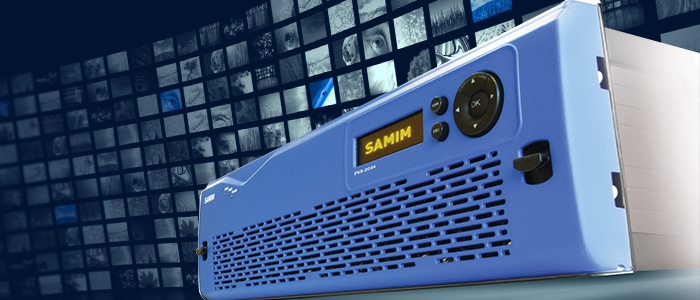
Share
- News
About CWDM technology
What are SAMIM CWDM and its functions in broadcast industry?
Often, a fiber optic signal line can be divided into smaller parts with the same wavelengths or be merged in a larger set of a main signal stream. This is called Wavelength Division Multiplexing or WDM. Multiplexers enable you to grow your media transmission capabilities without even adding a simple optical fiber link. An important advantage of WDM is that it is not related to the bit rates and the network protocols. This means that every single channel from the optical fiber, can carry every format and therefore, economize your infrastructure department costs.
Multiplexers can convert several inputs to a single output and transmit it through an optical fiber link, while the role of demultiplexers is to split the fiber optic signal and convert it to several fiber outputs in different wavelengths. The capacity of a WDM system depends on the ability to put the optical channels close to the wavelength domain. The channel spacing in CWDM technology is 20 nm apart, so it can support 18 wavelength channels in a 1270 nm to 1610 nm spectrum grid.
Expanding the sources in the signaling of the broadcast field, these multiplexers can support the transmission of audio and visual sources to the other streams without having to maximize the optical fiber links’ understructure, and consequently, they have been used to transmit streaming programs to different other streams.
What are the features of SAMIM 18 Channel Multiplexer/Demultiplexer?
Samim 18 Channel Optical Fiber Multiplexer/Demultiplexer known as OMD-1800, enables you to transmit optical signals with different wavelengths through an optical fiber link. This multiplexer/demultiplexer can merge up to 18 signals with different wavelengths into a single optical fiber, or transform 18 signals with different wavelengths from an optical fiber to 18 optical fiber channels. Also, it can create every combination of inputs and outputs on its 18 channels and can support a two-way link.
1- Samim multiplexers with electrical to optical and optical to electrical transformers, support signals like 3G/HD/SD-SDI, DVB/ASI, and Ethernet and use them for audio and visual signaling, economize costs.
2- Supporting the ITU-TG694 standard is one of the other Samim multiplexers’ features. This standard which was set in 2003 by ITU (International Telecommunication Union), supports wavelengths up to 20 nm spacing.
3- Samim CWDM card is a passive optical multiplexer/demultiplexer, and this means that Samim OMD-1800 does not need an electrical power source. Also, this card is so mechanically compatible with Samim frames and can easily be placed into them.
4- Also as you may know, due to the low weight, high quality, and higher certainty of the optical fibers, using them in telecommunication systems has been expanded, and it is also one of the most functional tools in the broadcasting market. One of the functional features of Samim multiplexers is the coverage of several signals on a single optical fiber link. This feature enables you to transmit several audio and visual channels with different wavelengths on one optical fiber and minimize your costs.
More Blog
- Academy
- Article
Optical Communication (Part 2)
The first use of fiber optics for transmitting TV production signals dates back to more than 40 years ago during the […]
- Academy
- Article
Optical Communication (Part 1)
The first use of fiber optics for transmitting TV production signals dates back to more than 40 years ago during the […]
- News
Digital/Analog Audio Video Signal Distribution
The first use of fiber optics for transmitting TV production signals dates back to more than 40 years ago during the […]
- News
Fiber Optics and TV Production Industry
The first use of fiber optics for transmitting TV production signals dates back to more than 40 years ago during the […]
- News
Samim Group Attended HAMBURG OPEN 2024
Samim Group attended HAMBURG OPEN Exhibition 2024 to introduce their latest technologies and products in […]
- Article
Samim SDI Router
An SDI router, also known as a video matrix, is a device for quick and flexible routing of input signals to various destinations. These devices are commonly used in
- News
- Academy
Setting up a 4k network using IP and SDI platforms
Two SMPTE-2110 or 12G-SDI IP platforms can be used to implement a 4K network. Choosing either of these two methods […]
- News
Audio Video Quality Processing
Audio and video are both kinds of digital or analog signals. We can process them to improve their quality, […]
- News
- Article
SAMIM IP Studio Intercom
The importance of real-time communication within different intra-organization departments […]
Contact us right now
If you prefer to speak directly to our sales or support teams, do not hesitate to get in touch with us right now.
or, Let us contact you at a later time
If you prefer us to contact you as soon as possible and discuss your specific requirements, please fill out the following form.
"*" indicates required fields








